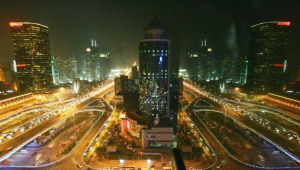
Over the next two decades, 2.6 billion new consumers will enter the ranks of the global middle class. This rise in global wealth is expected to test the ecological limits of the planet as demand for raw materials, food, and fuel rise, water becomes more scarce, and global warming makes the climate less certain.
The only way to avoid these very real threats to our long term prosperity is to make economic growth radically cleaner and leaner. This process begins at home by passing comprehensive climate and energy legislation.
The following is a list of 5 ways our world is expected to change under business as usual growth assumptions:
1. The second world becomes the “new” first world
The combined GDP of the largest emerging countries (Brazil, Russia, India and China or BRICs) is expected to be larger than the G7 developed countries by the year 2035. This power shift from the “old” first world to the “new” first world is likely to create significant tensions in a resource constrained world.
2. Global demand for many commodities triples
Demand for key industrial commodities like steel is expected to triple over the next two decades as another 700 million passenger light duty vehicles hit the road. India and China alone are fore casted to increase vehicle purchases by 250 million cars as their populations grow richer. Demand for copper, bauxite, and other raw materials are also expected to rise significantly as countries aim to double global gross power generation capacity at a cost of nearly $14 trillion.
3. Rising oil demand to be met with new finds in unstable countries
Oil demand from China and India is expected to nearly double over the next twenty years. This rise in demand is expected to create new global tensions as nearly two-thirds of existing oil wells will have run dry by this time and new finds will be sourced by politically and socially unstable countries.
4. Food demand to rise 50% as arable land and water become more scarce
Food production will need to increase 50% by 2030 as a larger, richer global middle class increases their daily caloric consumption. This will create one of the biggest challenges as growth rates for arable and harvest able land are predicted to slow while the population in areas under extreme water stress rises from the current 3 billion to 4 billion by 2030.
5. The planet will struggle to meet these challenges
Increased demand for just about everything is expected to put yet more pressure on the planet’s carrying capacity. According to Global Footprint, the world, which already exceeded its bio-capacity in 1990, will be running at an unsustainable 180% of its carrying capacity by the year 2030.
Clearly these changes are far from trivial and are likely to become even more challenging due to the impacts of climate change. While climate deniers argue that the planet has gone through warming spells before and as such there is no reason to be concerned about these impacts, this narrow-minded thinking completely ignores the real life risks of having 8.2 billion people generating over $100 trillion of GDP, on a planet already running far beyond its carrying capacity (the business as usual case in 2030). When these factors are taken into consideration, it becomes painfully obvious that we are running a sub-prime bet on our future where even modest climate missteps are likely to prompt situations that can quickly spiral out of control.
While passing comprehensive energy and climate legislation won’t change the global growth trends, it will enable the US to step up and help transition the global economy to a low carbon, lower impact growth model. This powerful leadership role would also help US companies to grow jobs and profits, enhance our energy security, reduce risks to our military personnel, and keep global growth from pushing the planet beyond is limits.
This post originally appeared on NRDC's Switchboard.
Andy Stevenson is a Finance Advisor for the Natural Resources Defense Council. NRDC is a non-profit organization dedicated to protecting the environment, people and animals. NRDC was founded in 1970 and is comprised of more than 300 lawyers, scientists and policy experts, with more than one million members and e-activists.

